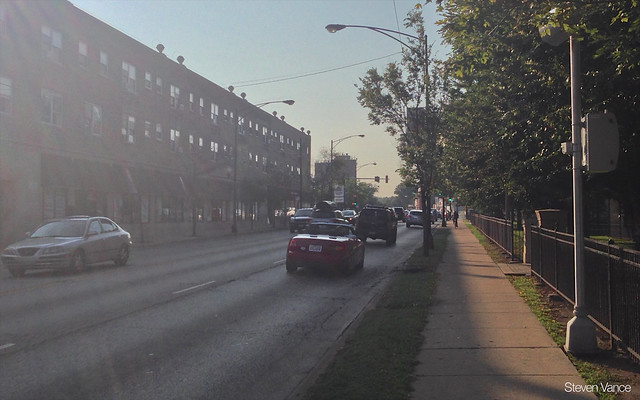
Fast times on Ridge Avenue, in front of Senn High School, are now over: The speed camera that CDOT installed in front of Senn Park has sharply cut the number of speeders cruising at a dangerous 40+ mph. Right after the camera was first installed, roughly seven out of 1,000 drivers received an official mailed warning for driving more than 10 mph above the speed limit. After the camera had been on for 44 days, it finally began issuing citations but sent tickets to fewer than two out of every 1,000 drivers.
While researching street conditions on Ridge Avenue for an upcoming article Streetsblog crunched the numbers from the first days of Senn Park's speed camera, to see whether it was working. The change was startling: During the 30-day initial warning period, 6,725 vehicles received warnings for driving more than 10 mph over the speed limit – but in the first 30 days of live citations, only 1,811 vehicles were ticketed. That's a 73 percent drop in the number of dangerously speeding drivers. That rate remained the same well into the camera's second month of issuing citations.
Ridge Avenue is subject to the citywide speed limit of 30 mph, and the speed camera only monitors traffic during park hours, which are from 6 a.m. to 11 p.m. Although Illinois law allows citations for drivers going 6 or more mph over the speed limit, CDOT currently only issues warnings or citations when its cameras see a car exceeding the speed limit by 10 mph or more. Since Ridge at this location is within a school zone, with a speed limit of 20 mph when children are present between 7 a.m. and 4 p.m., the camera could also enforce that lower limit.
Streetsblog followed up with our own speed survey of our own, training our radar gun just south of the camera at Wayne Avenue – and found that although the camera may have tamed truly dangerously high speeds, drivers are still going too fast on this block. Wayne is right where drivers see "SAFETY ZONE" painted across each lane, but before where the speed camera monitors northwest-bound cars.
During one weekday rush hour, 35 out of 195 drivers in the curbside lane over 15 minutes – 18 percent – were exceeding the 30 mph speed limit. None of these drivers were going fast enough to trigger the camera, and thus a ticket, but all of them were still putting pedestrians at risk. Had any of them happened to crash into a pedestrian at those speeds, the pedestrian would probably have died: a majority of people hit by cars at 30 mph live, while 80 percent of those hit at 40 mph die.
Correction: The number of drivers observed speeding was misreported. 18 percent of drivers were clocked speeding, not 68 percent. I regret the error.




